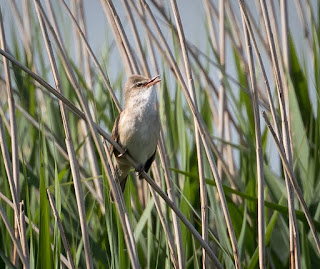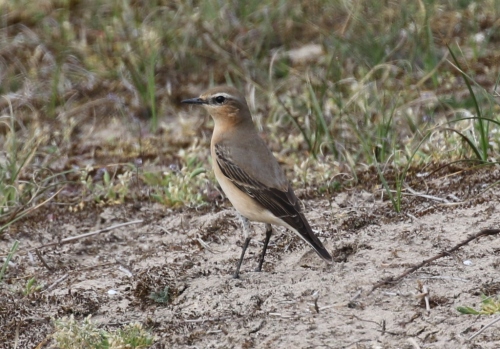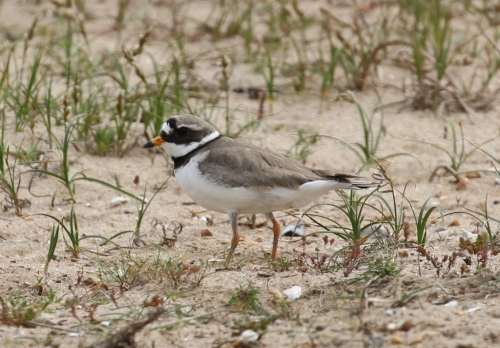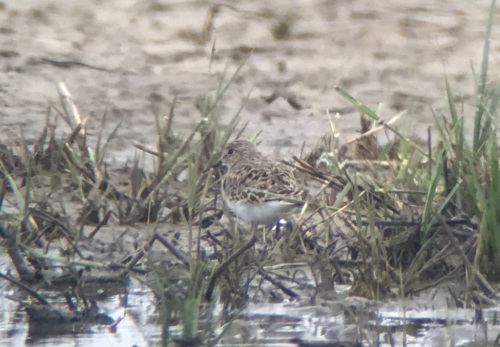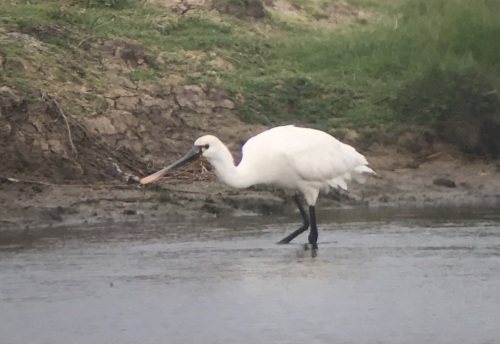Day 3 of a three day long weekend of tours today, back in Norfolk. It was cloudy most of the day, although we didn’t see any of the forecast rain (as so often happens!!). It then brightened up later on and was a lovely warm, sunny finish to the day.
Our first destination for the day was Titchwell – if it was going to rain at all, we thought we could make use of the shelter of the hides here. As it was still fairly quiet when we arrived, we had a look around the overflow car park. There were a couple of
Blackcaps singing and two
Stock Doves in a dead tree beyond the paddocks from the gate but no sign of any Turtle Doves which had been here earlier. It seems very early morning is best and they are probably still flying off site to feed during the day. A
Common Swift west overhead was the first of many we would see today.
Round at the Visitor Centre, the feeders produced several
Goldfinches and a
Greenfinch. While we were standing here, we heard a
Cuckoo singing just beyond, somewhere along the start of the main path, so we walked round to try to see it. By the time we got there though it had moved on.
When we got round to Patsy’s reedbed, we could hear the
Cuckoo singing again. It had gone round the other side to Willow Wood now, and was obviously hidden somewhere in the trees. There was not much on the pool here today, just a few
Tufted Ducks, a pair of
Common Pochard and a pair of
Shoveler. Two
Little Grebes were chased out of the reeds just below the screen by an aggressive
Coot.
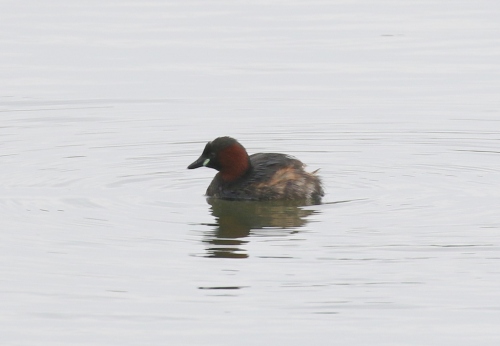
Little Grebe – one of two on Patsy’s Reedbed this morning
There were a couple of
Marsh Harriers circling over the reeds beyond and several
Common Swifts hawking low for insects. As we stood here and scanned, small numbers of hirundines were moving west –
Swallows and a few
House Martins.
As we walked back round via Meadow Trail, we could hear the
Cuckoo again. It sounded like it was round by the back of the Visitor Centre and then beat us back to the main path – it was very mobile! When we got out of the trees, we could hear it singing out over the saltmarsh and we had a quick glimpse of it in the top of a bush in the distance before it headed off towards Thornham Point.
There were lots of
Reed Warblers and
Sedge Warblers singing in the reeds below the main path, and we had nice views of both feeding up in one of the small sallows. We stopped by the reedbed pool to watch several
Bearded Tits flying back and forth low across the water. A couple of pairs chased each other up higher into the air, before dropping back down into the reeds. There were more
Swifts now hawking over the reeds, and moving slowly off west.
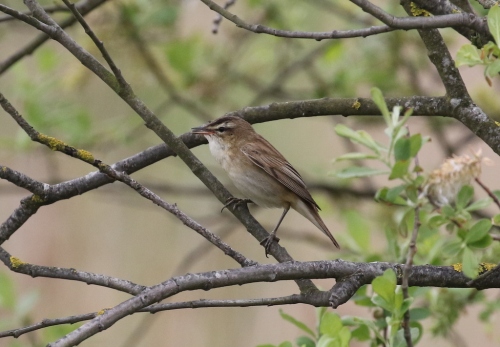
Sedge Warbler – in the sallows on the edge of the reedbed
Out on the Freshmarsh, there were not as many waders as we had hoped there might be, given the small groups we had seen dropping in at Cley yesterday afternoon. There were four
Ruff, smart males of various colours, asleep on one of the islands. When they woke up they quickly flew off west.
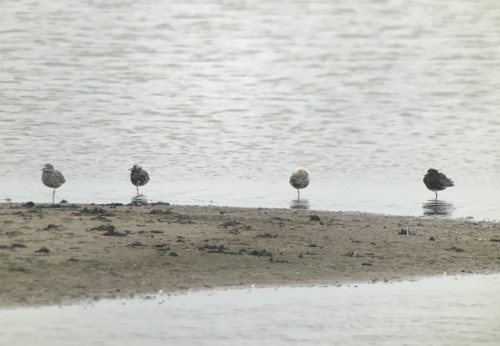
Ruff – four males resting on the Freshmarsh before flying off west
Other than those, we could only see one
Turnstone, one
Black-tailed Godwit and one
Common Redshank. There are not that many
Avocets on here at the moment either, although we could see a few pairs out in the fenced-off island, and several more feeding out in the water. Four
Avocets were busy having an argument just below the path.
There are not many ducks left on here now, with most of the winter visitors having departed. The
Red-crested Pochard were probably the most obvious, with a pair on the edge of the reeds shepherding eight ducklings, and another pair over just beyond Parrinder Hide. There were also a few
Shelduck and
Shoveler and one lone drake Teal, a useful addition to the list! Two
Pink-footed Geese feeding on the bank looked to be injured birds, and one had an obviously broken wing.
The Freshmarsh has been largely taken over by gulls and terns and a careful look through them revealed our main target here, a single
Little Gull. It was on one of the islands in front of Parrinder Hide, so we made our way round for a closer look. It was a 1st summer, a dainty little gull with a rounded head and thin black bill. Thankfully, we had all had a good look at it through the scope before it flew off.
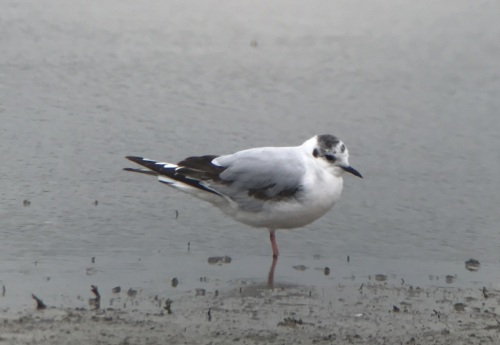
Little Gull – this 1st summer showed well from Parrinder Hide
The fenced off ‘Avocet Island is now dominated by gulls, mainly
Black-headed Gulls which had decided this is a nice safe place to nest. We could see quite a few pairs of
Mediterranean Gulls in amongst them, their jet black heads and brighter red bills particularly standing out. One or two
Mediterranean Gulls came in to collect nest material from the bank just outside the hide with the
Black-headed Gulls.
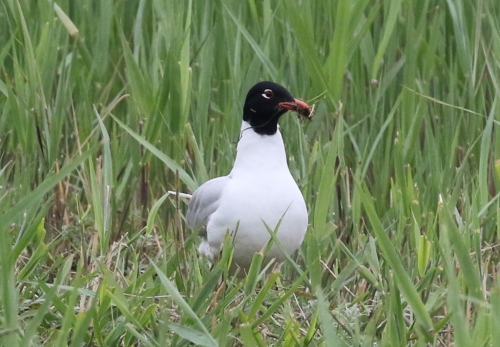
Mediterranean Gull – collecting nest material from the bank by the hide
Several
Common Gulls were loafing on the smaller islands in front of the hide, mostly 1st summers but including one adult which we had a good look at through the scope. There were quite a few
Sandwich Terns on here too still and we watched a pair displaying and then mating. It will be interesting to see if they stay to breed here. A pair of
Common Terns were keeping to themselves on another island out in the middle.
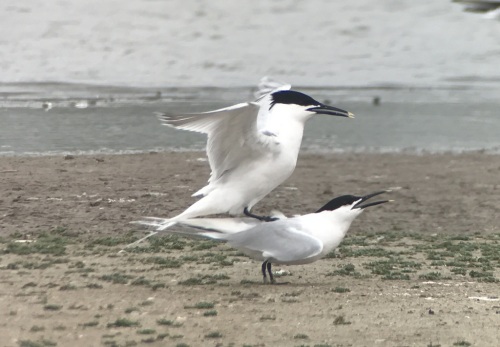
Moving on. there was very little on Volunteer Marsh today, with the mud baked quite dry now after the recent hot weather. One
Curlew was feeding in the channel at far end. The (no longer tidal) Tidal Pools are still flooded with seawater and pretty much devoid of life, apart from a handful of ducks. Three more
Red-crested Pochard flew in and landed on here briefly.
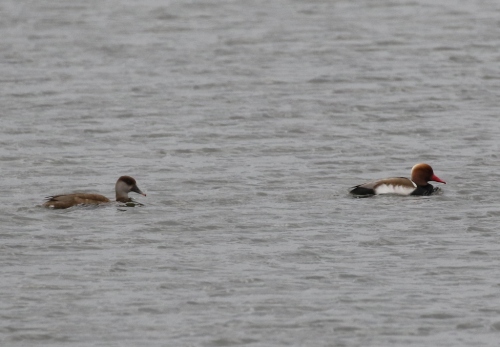
Red-crested Pochard – two of three which landed on the Tidal Pools
At the beach, the tide was out now. We could see a selection of waders down on the mussel beds so we walked out for a closer look. There were several very smart
Grey Plover, black below and white spangled above. Quite a few
Sanderling, looking very different now in breeding plumage, blended in very well against the browns and greys of the mussel beds. There were
Turnstone too, several also now looking very smart, and a few
Bar-tailed Godwits.
There were a few terns moving back and forth just offshore and we watched one or two
Common Terns and
Little Terns hunting just beyond the edge of the sand. A careful scan of the sea revealed a single
Common Scoter on the water and another flying off west. A couple of
Fulmar flew west too, hugging the surface of the sea.
As we walked back, we could hear the
Cuckoo again, now singing out towards Thornham, across the other side of the grazing marsh. We managed to find it up perched on the top of a hawthorn bush in the distance and got it in the scope. Finally, we had seen it! Three
Little Gulls, all 1st summer, were now hawking over the reedbed pool, catching insects with lots of other gulls.
Almost back to the Visitor Centre, we heard a
Siskin singing in the willows above the path. As we walked past, it dropped down onto the feeders. It was time for lunch now so we stopped to eat on one of the picnic tables by the Visitor Centre.
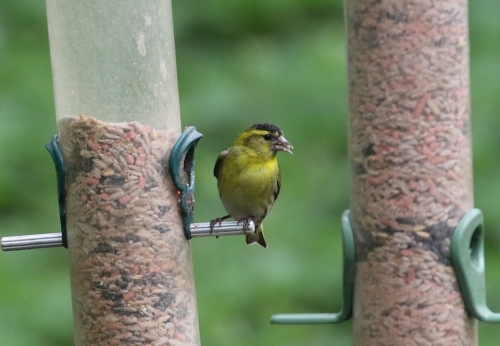
Siskin – dropped in to the feeders briefly
After lunch, we headed inland to Choseley. There were a couple of
Yellowhammers by the road on the way up but otherwise it was fairly quiet around the drying barns. We dropped down again to the coast at Holme, where we thought we would have a quick look in the paddocks. The sun was out now, and it was quickly warming up.
As we walked back along the bank, a
Common Whitethroat was subsinging in the brambles, and appeared to be chasing a female, but remained unusually mostly hidden in the vegetation. A
Willow Warbler was singing in a small sallow, and we could see the lovely light lemon yellow wash on its breast in the sunshine. A pair of
Lesser Whitethroats were flicking around in the top of a large hawthorn bush briefly before they flew off.
We could hear another
Cuckoo singing, but it sounded to be some way off at first. Helpfully, it then flew in and landed in the top of one of the poplars in the paddocks briefly. Everyone had a good look at it through binoculars and one or two through the scope before it quickly moved off west. We could still hear it singing away in the distance.
Stiffkey Fen was to be our final destination. After driving back east, we parked and walked down the permissive path the other side of the road. The meadow here was looking beautiful, peppered with blue flowers, and we watched a couple of Marsh Harriers flying back and forth.
As we got to the copse at the end of the meadow, we looked back to see a male
Marsh Harrier drop down and catch something. We couldn’t see what it was, but we had seen a couple of
Brown Hares running back to the spot where it dropped, as it approached. The
Hares were still there, looking agitated. The
Marsh Harrier flew off out into the middle and dropped down into the reeds.
A minute or so later, a different male
Marsh Harrier appeared over the meadow and headed over to where the
Hares were, running around and rearing up on their back legs. The
Marsh Harrier dropped several times, before it came up with a leveret in its talons. It flew off, chased by one of the
Hares on the ground below, disappearing round behind the wood towards the Fen. Nature red in tooth and claw!
There was a small wet flash down in the valley below, a flooded area of grass, and we noticed a small wader on the far side of it. Through the scope, we could see that it was a
Wood Sandpiper, one of the scarcer waders which we would hope to come across at this time of year, right at our last stop! We could see its spangled upperparts and pale supercilium.
On the walk out to the Fen, there were lots of insects out in the sunshine. We saw a couple of
Four-spotted Chasers, our first dragonflies of the year. Butterflies included
Orange Tip and
Green-veined White, plus a surprise
Painted Lady later up on the seawall, which was also the first of the year. A bee mimic
Hoverfly (
Volucella bombylans) was also of interest.
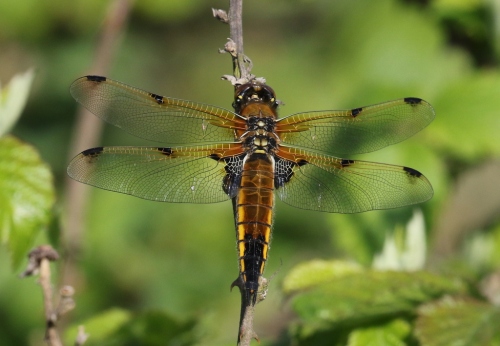
Four-spotted Chaser – our first dragonfly of the year
We could hear a
Greenshank calling as we walked out and just see it over the top of the reeds, on the edge of one of the islands out on the Fen. From up on seawall, we could actually see two
Greenshanks, both roosting here over high tide. Otherwise, there were two
Little Ringed Plovers, a couple of
Redshank and several nesting
Avocets.
As we walked along the seawall, a
Common Sandpiper flew out from the edge of the channel below us and across to the other side, where we could see it bobbing up and down on the bank. A pair of
Common Terns were fishing, diving in the channel, and flew right past us.
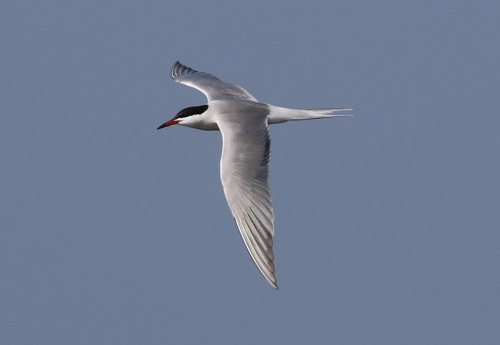
Common Tern – a pair were diving in the channel
There were lots of
Brent Geese out on the saltmarsh and scattered around the edge of the harbour and we could see a pair of
Little Terns flying past over the water. The tide was still coming in, but not far off high now – we could see all the boats going out to look at the seals hauled out on the tip of Blakeney Point in the distance. There were a couple of groups of
Oystercatchers roosting around the edges of the harbour and a little party of three
Dunlin and three
Ringed Plover down on the shore nearest us.
There were a few people walking around the edge of the harbour, out across the saltmarsh, and a dog running around too. They flushed a larger flock of waders from somewhere out of sight, which then whirled round over the water. As it landed, there seemed to be a smaller bird in with them. The birds all dropped down again in the distance, and disappeared amongst the stones on a shingle spit.
As they started to move around, we could see mostly
Ringed Plover and
Dunlin, plus a couple of
Turnstone at first. Then the smaller one reappeared on the near edge of the flock, a
Little Stint. We could see its rusty fringed upperparts, short bill and clean white underparts. It was very hard to pick out at first, given the heat haze, but eventually it stopped to preen and everyone managed to get a look at it through the scope.
The great wader selection here was completed with a
Whimbrel which unfortunately flushed from the edge of the harbour and flew off before everyone got a chance to see it. Just as we were preparing to leave it flew in again past us and landed on the saltmarsh where we could get it in the scope. Very helpful! A male
Marsh Harrier flew in right over our heads too.
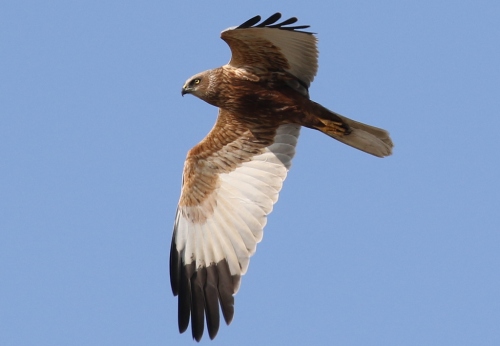
Marsh Harrier – this male flew in from the harbour over our heads
It was beautiful out here on the edge of the harbour in the sunshine this afternoon, and with a great selection of birds to look at too. Eventually we had to tear ourselves away and make our way back. As we walked back along the path by the Fen, a
Barn Owl flew round the bushes in front of us. It saw us and turned sharply, flying back the way it had come. But when we got back to the car, we could see it hunting over the meadow the other side of the hedge.
That was a great way to end the tour, three enjoyable days with an excellent selection of birds along the coast. However, on our way back we noticed the
Peregrine was back on the church tower where we had seen it yesterday, to wave us off.

Peregrine – back on the church tower at the end of the day

